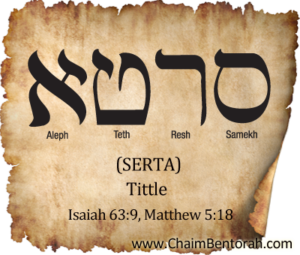ARAMAIC WORD STUDY – THE TITTLE – SERTA סרטא Samek Resh Teth Aleph
Isaiah 63:9: “In all their affliction he afflicted…”
Matthew 5:18: “For verily I say unto you, Till heaven and earth pass, one jot or one tittle shall in no wise pass from the law, till all be fulfilled.”
Here is something I have never understood about the Biblia Hebraica Stuttgartensia or the Kittle which is the standard Masoric text used by our Western Christian translators as well as in seminaries and Bible Colleges. For you Hebrew students, check out the word lo in Isaiah 63:9 in your Hebrew Bible. You will notice a (.) above the word. In your Kittle or Stutgartensia you will see a (o) above the word. What that little mark means, that even translators tend to ignore is that this is not what is found in the original text, it is Oral Tradition.
 To those of us who believe the Bible is the inspired, inerrant Word of God, that little mark is very important. Jesus warned in Matthew 5:18; “For verily I say unto you, Till heaven and earth pass, one jot or one tittle shall in no wise pass from the law, till all be fulfilled.”
To those of us who believe the Bible is the inspired, inerrant Word of God, that little mark is very important. Jesus warned in Matthew 5:18; “For verily I say unto you, Till heaven and earth pass, one jot or one tittle shall in no wise pass from the law, till all be fulfilled.”
I found my seminary teachers had other ideas as to what the jot and tittle was than I found Jewish scholars had, which is scary in way. The standard Christian teaching was that the tittle was the tagin found in the Sefer Torah and the Magilan Esther (hand written portions of the Bible). You also find it on the terrillin and mezuzahs. This made little sense to me, as the tagin each have special meanings which are not inspired, so why would Jesus condemn the changing of something that was not inspired. So I went with the secondary explanation that the “tittle was like the foot on the Taw and if you eliminate that, you have a Cheth. I taught that until a rabbi recently laughed at me when I mentioned this. He laughed at me.
A Hebrew scholar who was an ultra orthodox rabbi, pointed out that in the Greek the word that has been translated as tittle is keraia. The word tittle comes from the Latin which was first used in the 11th Century to distinguish the letter “i” from strokes of nearby letters. Although originally a larger mark, it was reduced to a dot when Roman-style typefaces were introduced. It is called a diacritic. Hence the word tittle means the dot above the lower case “i” or “j.” In Greek the word keraia means a hook or serif and was most likely referring to a Greek diacritic. Iota is the smallest letter of the Greek alphabet and was used as a small diacritic called a hypogegrammeni. The word jot is Yod in Aramaic. The Iota is like the Yod in the Hebrew and Hebrew as the smallest letter of the alphabet. I am ok with that but it is the keraia or tittle that has me wondering. The word is Aramaic for tittle is serta which means a scratch, line, point of a letter just a stroke of a pen. In its Semitic root it is used for a scratch like wound or mark.
Would you like Chaim Bentorah as your personal Hebrew teacher?
|
|
That leaves it open to a number of possibilities, but Jewish scholars tend to point to Isaiah 63:9 and the mark over the word “lo” as a title. If this is the case then what Jesus is telling us in Matthew 5:18 is to go with the original manuscript and not what Oral Tradition tells us.
Hence your Kittle or Stuttgartensia will not give you the original word, it only gives what oral tradition dictates with a little tittle above it to alert you to the fact that there is another word used here and it could only find that word in the Sefer Torah or other Jewish copies of the original Hebrew.
You see the word lo in this verse is written differently than it is read. It is originally written as lu. The original uses a Vav and not an Aleph. Lo mean no or “there is not.” Lu means “he.” Both readings were meant to be combined so it could be translated correctly. Because our English versions overlook this tittle our rending of this passage in Isaiah 63:9 is a reference to the coming Messiah, Jesus: “In all their affliction He was afflicted.” That is comforting, but there is more to it. If we pay close attention to this tittle and as a good Christians should, we see this passage when speaking of Jesus, to also be rendered as: “In all their afflictions, He is afflicted, THEN THERE IS NO AFFLICTION.” The rabbi (who sees the “He” as God and not Jesus) pointed out this little oversight we Christians make and added: “When one knows how to praise God in this way, the suffering will disappear by itself.” In other words when a person realizes that God is present in all his afflictions, then your affliction is shared with Jesus and He can make the afflictions themselves cease to exist.”
Hi there! Thank you for reading this Daily Word Study. Can I ask a favor? Share this Daily Word Study with your friends on Facebook and Twitter by clicking one of the icons below.
Thanks & Blessings, it means a lot to me!







I thank The MOST HIGH for persons like yourself who spend time before HIM to understand HIS Truth and dispense it into the hearts of us who would read and walk in it. I bought your book a few years ago and has yet to complete it, I will try to do so in the near future as I often times find your insight inspiring and very helpful. May the Blessings of HIS presence continue to enlighten you and sustain you.
I love this. We so often translate how we see and feel the world through
our emotional lenses and five senses. It is NOT that it is not real, but in
Jesus there is actually a transition into new heart and kingdom sight that
changes how we experience life. IN HIM IS LIFE AND THAT LIFE IS THE LIGHT OF MEN.
Still walking out the fullness of all of this, but definitely SEE a difference in how
I EXPERIENCE life, as I remember WHO is with and in ME and the better my REMEMBER gets, the quieter my life flows.
Lord Jesus please cause my afflictions to cease to exist as sure as the day follows the night, Amen.
I so enjoyed this study. Thank you
Thank you again
Your words as always are very enlightening and I highly praise all who try to bring us closer to God and His Beloved Son . Since God placed the Spirit of His Son within the Jewish people I try to learn as much as I can from Jewish sources . I do use caution when Orthodox Rabbis tell Christians anything because some believe that it is right with God to deny Jesus as Messiah and may try to undermine your belief . This doesn’t mean I don’t listen and learn from Rabbis of every type from ultra Orthodox to Reformed and as well as Messianic Jewish Rabbis . Most all Rabbis are very willing to to teach you honestly .
I recently learned that the Torah was originally written in a different script than the one that is taught today . The original used a script more like the pictographs which were used in ancient times much like hieroglyphs of Egypt . Can you throw some light on this ? I read it on Chadbad.org
Gladys, all script originated from pictographs. As long as the message is the same, that’s what’s important.
Biblical Hebrew was never in a pictograph form. B.H. originated through the cuniform, a phonetic based writing system. If you are referring to “The Ancient Hebrew alphabet”, that is a misnomer. It’s actually an ancient Canaanite, Paleo, alphabet which was a Pagan culture. For example, the letter aleph was represented as a bull/ox head, which was their god Apis (what the golden calf represented). Thats why Ezra, the scribe changed the script so that the aleph represented the name of God as its a combination of letters that spell His name, yod vav yod, an appreciation for the name of God.
For any one interested in learning more about the ancient writing systems, join us at https://www.hebrewwordstudy[tag]https://www.hebrewwordstudy.com%5B/tag%5D.com where Chaim goes into depth on topics such as this.
Laura, thank you for the explanation of B. H.. How about the chronology in the Septuagint, can it be explained?
Thank you for your comments, good interaction!
Hi Chaim, in the Septuagint ( Greek ) the ages of Adam, Seth, Enosh, Mahalalel and Enoch, when their sons are born, are 100 years more than that in the Hebrew. I am wondering how this could have happened.
There are two calendars, religious/ceremonial and civil. With regard to the measure of years there were adjustments between the writing of Genesis and the Septuagint. I just read there is one third world nation that uses a different calendar than we do and it is 2006 in that nation. 40 year olds are actually 50 according to our calendar.